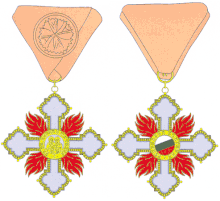Order of Saints Cyril and Methodius
The Order of Saints Cyril and Methodius was founded on May 18, 1909 by the Bulgarian Tsar Ferdinand I and ranked first in the country's award, which was awarded exclusively to the highest state representatives. After the end of the monarchy in the People's Socialist Republic on December 13, 1950, an award with the designation order "Kyrillos und Methodios" was awarded , which was awarded for services to science , culture and education . On April 5, 1991, this was abolished after the communist era. By resolution of the People's Assembly on May 29, 2003, the original form of the award for services to science, culture and education was restored.
Tsarist Empire (until 1944)
Order classes
The order was donated in only one class and consists of a grand cross , which was worn either on a collar or on a sash and with a breast star .
Order decoration
The sign of the order is a silver gilt, light blue enamelled Byzantine cross. Green enamelled bundles of rays are attached to the cross angles, each with a stylized lily . In the medallion on top, the figures of Saints Cyril and Methodius can be seen standing side by side. The medallion is surrounded by a golden ring with the blue enamelled inscription EX ORIENTE LUX (light comes from the east).
The breast star has the shape of a Maltese cross and is made of silver. In the corners of the cross you can see blazing flames with a lily on top. Lying horizontally on the cross are two golden wings, some of which are enamelled in red, with a saint's face in the middle. Swings can also be seen vertically, symbolizing the movement of the horizontal wings.
The links of the collar are silver-gold-plated and alternately show a standing, crowned lion , turned to the left, and a lily.
Awards
The number of Bulgarian knights was limited to fifteen people, with only nine awards being made. In addition, another 52 foreigners, mostly monarchs, received this highest award.
- Tsar Ferdinand I
- Prince Boris
- Prince Cyril
- Josef I. , Exarch in 1912
- Ivan Geschow , Bulgarian Prime Minister in 1913
- Vasil Radoslawow , Bulgarian Prime Minister in 1918
- Ivan Vazov , Bulgarian writer in 1920
- Simeon von Warne-Preslaw, Metropolitan in 1922
- Danail Nikolaev , Bulgarian infantry general on May 6, 1936
- Nicholas II , Tsar of Russia
- Wilhelm II , German Emperor
- Franz-Joseph I , Emperor of Austria-Hungary
- George VI. , King of Great Britain and Emperor of India
- Victor Emmanuel III , King of Italy
- Frederik VIII , King of Denmark
- Alexander I , King of Serbia, Croatia and Slovenia
- Albert Lebrun , President of the French Republic
- Ignacy Mościcki , President of the Polish Republic
- Hermann Göring , Commander in Chief of the German Air Force, Nazi politician
- Benito Mussolini , Prime Minister of Italy
- Joachim von Ribbentrop , Foreign Minister of the German Reich, Nazi politician
- Miklós Horthy , imperial administrator and head of state in Hungary
People's Republic (1950–1991)
stages
The award consists of three stages:
- 1st stage - gold with red enamel
- 2nd stage - gold with blue enamel
- 3rd stage - silver with blue enamel
Appearance
The award is a round medal with a red or blue enamel background. It shows the image of the saint in relief . In the left foreground Cyrill , holding a scroll with the first four letters of the Cyrillic alphabet in his hands. Slightly offset to the right behind Methodios with a Bible under his arm. A five-pointed star can be seen on the medal at the top.
Carrying method
The award is worn on a light blue ribbon on the left side of the chest.
Awards
On May 22, 1951, the Bulgarian mathematician Nikola Obreshkov (1896–1963) was given this award for the first time. All three classes were awarded a total of 48,200 times.
Republic (since 2004)
Order classes
The order today consists of three classes:
Order decoration
The sign of the order is based on the shape of the tsarist times. However, the flames in the cross corner are no longer covered with a lily and instead of the crowned name code, the national colors of the country can be found on the lapel. The first two classes are gold-plated, the third class only silver-plated.
literature
- Dimitri Romanoff: The Orders, Medals and History of the Kingdom of Bulgaria. Balkan Heritage, Rungsted Kyst 1982, ISBN 87-981267-0-9 .
- Todor Petrov: Bulgarian Orders and Medals 1878–2005. Military Publishing House Ltd., Sofia 2005, ISBN 954-509-317-X .




